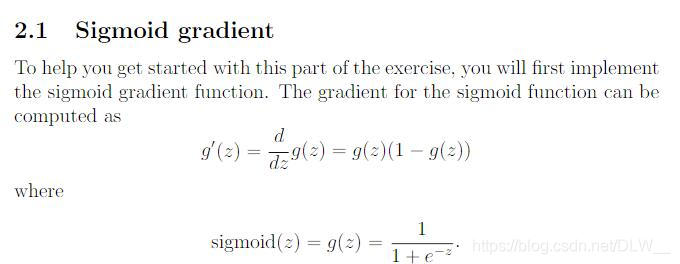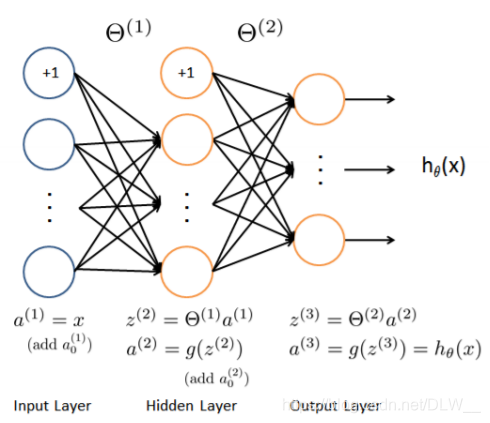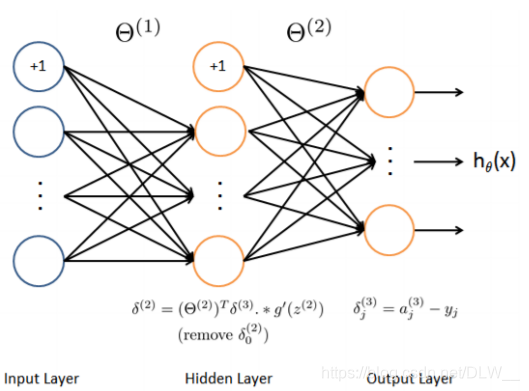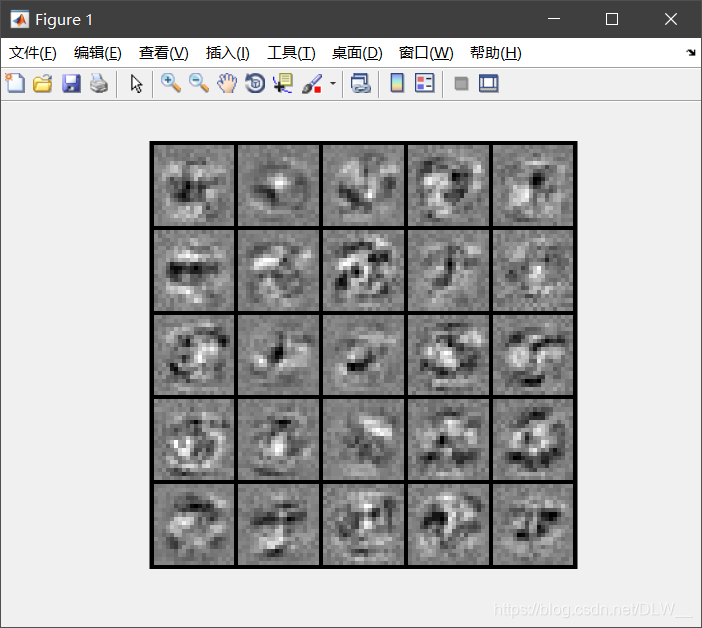ex4
github:https://github.com/DLW3D/coursera-machine-learning-ex
练习文件下载地址:https://s3.amazonaws.com/spark-public/ml/exercises/on-demand/machine-learning-ex4.zip
Neural Network Learning 神经网络学习
Sigmoid Gradient Sigmoid函数梯度

sigmoidGradient.m
function g = sigmoidGradient(z)
g = sigmoid(z) .* (1 - sigmoid(z));
end
Feedforward 前向传播
前向传播的工作主要是计算代价函数


Backpropagation 反向传播
反向传播需要计算输出层误差,通过误差传播方程计算出各隐含层神经元误差,最后进行参数的梯度计算.


nnCostFunction.m
function [J grad] = nnCostFunction(nn_params, ...
input_layer_size, ...
hidden_layer_size, ...
num_labels, ...
X, y, lambda)
%NNCOSTFUNCTION Implements the neural network cost function for a two layer
%neural network which performs classification
% [J grad] = NNCOSTFUNCTON(nn_params, hidden_layer_size, num_labels, ...
% X, y, lambda) computes the cost and gradient of the neural network. The
% parameters for the neural network are "unrolled" into the vector
% nn_params and need to be converted back into the weight matrices.
%
% The returned parameter grad should be a "unrolled" vector of the
% partial derivatives of the neural network.
%
% Reshape nn_params back into the parameters Theta1 and Theta2, the weight matrices
% for our 2 layer neural network
Theta1 = reshape(nn_params(1:hidden_layer_size * (input_layer_size + 1)), ...
hidden_layer_size, (input_layer_size + 1));
Theta2 = reshape(nn_params((1 + (hidden_layer_size * (input_layer_size + 1))):end), ...
num_labels, (hidden_layer_size + 1));
m = size(X, 1);
z2 = [ones(size(X,1),1), X] * Theta1';%m*25
a2 = sigmoid(z2);
a2 = [ones(size(a2,1),1), a2];%m*26
z3 = a2 * Theta2';%m*10
a3 = sigmoid(z3);%m*10
y_ = zeros(m, num_labels);%m*10
for i = 1:num_labels
y_(:,i) = (y == i);
end
J = sum(sum(-y_ .* log(a3) - (1-y_) .* log(1-a3)))/m +...
lambda/2/m * (sum(sum(Theta1(:,2:size(Theta1,2)).^2))+...
sum(sum(Theta2(:,2:size(Theta2,2)).^2)));
delta3 = a3 - y_;%m*10
delta2 = delta3*Theta2(:,2:size(Theta2,2)).*sigmoidGradient(z2);%m*25
Theta2_grad = delta3' * a2 / m;%10 * 26
Theta1_grad = delta2' * [ones(size(X,1),1), X] / m;%25 * 401
%正则化
Theta2(:,1) = 0;
Theta1(:,1) = 0;
Theta2_grad = Theta2_grad + lambda/m*Theta2;
Theta1_grad = Theta1_grad + lambda/m*Theta1;
% Unroll gradients
grad = [Theta1_grad(:) ; Theta2_grad(:)];
end
RandInitialize Weights 随机初始化参数
神经网络必需随机初始化参数.
randInitializeWeights.m
function W = randInitializeWeights(L_in, L_out)
epsilon_init=0.12;
W = rand(L_out, 1 + L_in) * 2 * epsilon_init - epsilon_init;
end
预测输出
predict.m
function p = predict(Theta1, Theta2, X)
m = size(X, 1);
num_labels = size(Theta2, 1);
p = zeros(size(X, 1), 1);
h1 = sigmoid([ones(m, 1) X] * Theta1');
h2 = sigmoid([ones(m, 1) h1] * Theta2');
[dummy, p] = max(h2, [], 2);
end
训练神经网络
% Load the weights into variables Theta1 and Theta2
load('ex4data1.mat');
input_layer_size = 400; % 20x20 Input Images of Digits
hidden_layer_size = 25; % 25 hidden units
num_labels = 10; % 10 labels, from 1 to 10
% (note that we have mapped "0" to label 10)
fprintf('\nInitializing Neural Network Parameters ...\n')
initial_Theta1 = randInitializeWeights(input_layer_size, hidden_layer_size);
initial_Theta2 = randInitializeWeights(hidden_layer_size, num_labels);
% Unroll parameters
initial_nn_params = [initial_Theta1(:) ; initial_Theta2(:)];
fprintf('\nTraining Neural Network... \n')
options = optimset('MaxIter', 50);
% You should also try different values of lambda
lambda = 1;
% Create "short hand" for the cost function to be minimized
costFunction = @(p) nnCostFunction(p, ...
input_layer_size, ...
hidden_layer_size, ...
num_labels, X, y, lambda);
% Now, costFunction is a function that takes in only one argument (the
% neural network parameters)
[nn_params, cost] = fmincg(costFunction, initial_nn_params, options);
% Obtain Theta1 and Theta2 back from nn_params
Theta1 = reshape(nn_params(1:hidden_layer_size * (input_layer_size + 1)), ...
hidden_layer_size, (input_layer_size + 1));
Theta2 = reshape(nn_params((1 + (hidden_layer_size * (input_layer_size + 1))):end), ...
num_labels, (hidden_layer_size + 1));
fprintf('\nVisualizing Neural Network... \n')
displayData(Theta1(:, 2:end));
pred = predict(Theta1, Theta2, X);
fprintf('\nTraining Set Accuracy: %f\n', mean(double(pred == y)) * 100);
Training Set Accuracy: 95.260000








 本文详细介绍了一个两层神经网络的学习过程,包括前向传播计算代价函数、反向传播计算梯度、随机初始化参数、预测输出及神经网络训练。通过具体代码实现,展示了如何使用随机初始化的参数训练神经网络,并评估其在训练集上的准确性。
本文详细介绍了一个两层神经网络的学习过程,包括前向传播计算代价函数、反向传播计算梯度、随机初始化参数、预测输出及神经网络训练。通过具体代码实现,展示了如何使用随机初始化的参数训练神经网络,并评估其在训练集上的准确性。
















 1420
1420

 被折叠的 条评论
为什么被折叠?
被折叠的 条评论
为什么被折叠?








